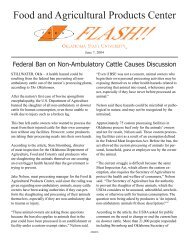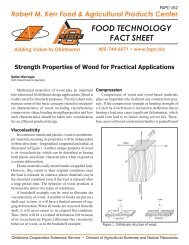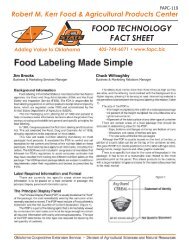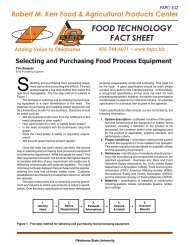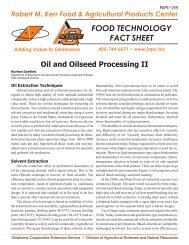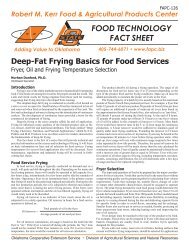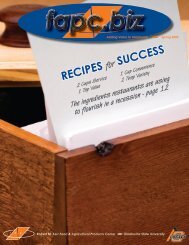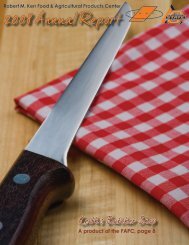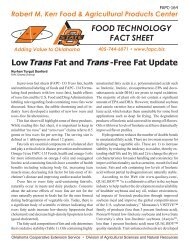Oil and Oilseed Processing III - Robert M. Kerr Food & Agricultural ...
Oil and Oilseed Processing III - Robert M. Kerr Food & Agricultural ...
Oil and Oilseed Processing III - Robert M. Kerr Food & Agricultural ...
You also want an ePaper? Increase the reach of your titles
YUMPU automatically turns print PDFs into web optimized ePapers that Google loves.
FAPC-160<br />
<strong>Robert</strong> M. <strong>Kerr</strong> <strong>Food</strong> & <strong>Agricultural</strong> Products Center<br />
f a p c<br />
Adding Value to Oklahoma<br />
<strong>Oil</strong> <strong>and</strong> <strong>Oil</strong>seed <strong>Processing</strong> <strong>III</strong><br />
Nurhan Dunford<br />
Department of Biosystems <strong>and</strong> <strong>Agricultural</strong> Engineering Associate Professor<br />
FAPC <strong>Oil</strong>/<strong>Oil</strong>seed Chemist<br />
Crude <strong>Oil</strong> Refining <strong>and</strong> Preparation for<br />
Biodiesel Production<br />
Crude oil obtained by both solvent extraction <strong>and</strong><br />
mechanical pressing contains desirable <strong>and</strong> undesirable<br />
compounds. Desirable compounds include triacylglycerides<br />
(TAGs) (neutral lipids) <strong>and</strong> health beneficial<br />
compounds such as tocopherols <strong>and</strong> phytosterols. Free<br />
fatty acids (FFAs), phospholipids (PLs), also referred to<br />
as gums, <strong>and</strong> lipid oxidation products are the major impurities<br />
removed during oil refining. There are several unit<br />
operations in a crude oil refining operation. Degumming,<br />
deacidification/refining, bleaching, deodorization <strong>and</strong><br />
winterization are commonly used for edible oil production.<br />
Vegetable oils to be used for biodiesel production<br />
must be at least degummed <strong>and</strong> deacidified.<br />
Degumming<br />
PLs are natural components of oils <strong>and</strong> oilseeds.<br />
They are not desirable because they settle out of the oil<br />
during shipping <strong>and</strong> storage. PLs have adverse effects<br />
on the color <strong>and</strong> flavor of oil. They are surface-active<br />
compounds that reduce interfacial tension between<br />
immiscible liquids, i.e. water/oil. The presence of PLs<br />
creates problems during oil processing <strong>and</strong> some food<br />
applications, i.e. frying. PLs are removed from oil during<br />
the degumming process.<br />
There are two types of PLs: hydratable <strong>and</strong> nonhydratable.<br />
In general, crude vegetable oils contain a small<br />
amount of nonhydratable PLs. However, the amount may<br />
vary significantly depending on quality of the seed, type<br />
of seed <strong>and</strong> conditions during the oil milling operation.<br />
<strong>Oil</strong> degumming is usually carried out at the crushing or<br />
FOOD TECHNOLOGY<br />
FACT SHEET<br />
405-744-6071 • www.fapc.biz<br />
extraction plant. Hydratable PLs can be removed from<br />
the oil by water-degumming. Hot water (at 160-176°F)<br />
or steam is injected into the warm oil. The amount of<br />
water/steam added depends on the amount of hydratable<br />
PLs present in the oil. As a rule of thumb about 2 percent<br />
water is added to oil <strong>and</strong> mixed for one hour during a<br />
batch operation. Continuous degumming processes utilize<br />
an on-line mixer for mixing oil <strong>and</strong> water (2 percent<br />
based on oil amount) <strong>and</strong> the residence time is usually<br />
10-15 minutes. During this process, PLs absorb water<br />
<strong>and</strong> lose their lipophilic (affinity to lipids) characteristics,<br />
become oil insoluble <strong>and</strong> agglomerate into a gum phase.<br />
Gums are separated by centrifugation <strong>and</strong> added back to<br />
meal. Gums can be further processed to produce lecithin,<br />
which is used as an emulsifier in food <strong>and</strong> feed applications.<br />
The residual phosphorous level in degummed oil<br />
is about 100 parts per million after water degumming.<br />
PL content of the oil can be further decreased to about<br />
30-50 parts per million by adding 1500-2500 parts per<br />
million organic acid into the oil at 104-131°F, a process<br />
called super-degumming. The oil from the degumming<br />
centrifuge is cooled to 90-100°F before entering a feed<br />
tank for the refining operation.<br />
There are also enzymatic degumming processes,<br />
which are already competing with traditional processes.<br />
Enzymatic degumming increases oil yields by converting<br />
hydratable PLs to diacylglycerols that remain in neutral<br />
oil <strong>and</strong> are not lost during the centrifugation process.<br />
Deacidification/Refining<br />
Good quality oil contains more than 95 percent neutral<br />
lipids (TAGs). Commercial crude oils usually contain<br />
Oklahoma Cooperative Extension Service • Division of <strong>Agricultural</strong> Sciences <strong>and</strong> Natural Resources
about 1-3 percent FFAs. High quality oils contain 0.5<br />
percent or less FFA. However, palm, olive, fish <strong>and</strong> some<br />
specialty oils such as wheat germ <strong>and</strong> rice bran oils may<br />
contain 20 percent or more FFAs. As an industry rule,<br />
the FFA content of refined oils should be less than 0.1<br />
percent. Although most of the long-chain FFAs do not<br />
significantly impair the taste of the oil, the short-chain<br />
FFAs may have a soapy <strong>and</strong> rancid flavor. Furthermore,<br />
FFAs accelerate oxidation reactions, consequently, reducing<br />
the oxidative stability of the oils. Crude oils are<br />
traditionally deacidified or refined by chemical methods.<br />
During chemical refining, a heavy soapstock (sodium or<br />
potassium salts of fatty acids) is formed. Soapstock is<br />
separated from refined oil by gravity settling, filtration<br />
or centrifugation. Sodium hydroxide, also referred to as<br />
caustic or lye, is widely used for chemical oil refining.<br />
The proper strength <strong>and</strong> amount of lye is critical for<br />
achieving high FFA removal with minimal neutral oil<br />
loss <strong>and</strong> degradation, <strong>and</strong> needs to be determined by trials<br />
for different oil types <strong>and</strong> quality. Not only the FFA<br />
content, but also the presence of color <strong>and</strong> surface-active<br />
compounds in oil make reaction of FFAs with lye highly<br />
variable. The amount of lye needed for refining soybean<br />
oil can be calculated from the following equation:<br />
[(% FFA x 0.142 + % excess) x 100 ] / (% NaOH in caustic)<br />
(E.G. Latondress, Journal of the American <strong>Oil</strong> Chemists<br />
Society, vol. 61, no. 8, pp: 1380-1382, August 1984).<br />
In oil refineries lye strength is measured by its specific<br />
gravity <strong>and</strong> expressed in degrees Baumé. The percentage<br />
of excess lye for degummed soybean oil is usually<br />
0.10-0.12 percent <strong>and</strong> the lye used for refining oil is 14-<br />
18°Bé (9.5-12.7 percent NaOH in water). Details for the<br />
calculation of lye requirement for refining can be found<br />
in Bailey’s Industrial <strong>Oil</strong> <strong>and</strong> Fat Products (3rd edition,<br />
editor, D. Swern, John Wiley & Sons, Inc., N.Y., 1964,<br />
pp.735-740). The degummed oil at 90-100°F is mixed<br />
with the required amount of lye <strong>and</strong> pumped through<br />
a high shear mixer. The mixing time is 5-10 minutes.<br />
Then, oil is heated to 165°F <strong>and</strong> centrifuged to remove<br />
soapstock (sodium salts of FFAs). Soda ash or sodium<br />
carbonate also can be used to remove FFAs from crude<br />
oil. However, carbon dioxide released during refining<br />
causes foaming. In addition, entrainment of gas in the<br />
soapstock prevents proper settling.<br />
In cottonseed, gossypol, a complex polyphenolic<br />
compound, contributes to oil toxicity <strong>and</strong> dark color<br />
<strong>and</strong> is regarded as an undesirable component. However,<br />
recent studies have shown that gossypol possesses an-<br />
160-2<br />
titumor <strong>and</strong> contraceptive activities in males. Today,<br />
gossypol is considered a value-added natural product<br />
from cottonseed with health beneficial properties.<br />
Nevertheless, during cottonseed processing, gossypol<br />
must be removed to produce edible oil <strong>and</strong> animal feed.<br />
Gossypol in crude cottonseed oil is typically removed<br />
in the miscella (mixture of oil + hexane) before hexane<br />
removal from the oil at the hexane extraction plants. In<br />
this process, the crude oil-hexane mixture (45-65 percent<br />
oil:35-55 percent hexane) is filtered to remove any meal,<br />
scale or insoluble impurities that may be carried from the<br />
extraction process. Next, the crude miscella is pumped<br />
to a reaction vessel, where lye is added <strong>and</strong> mixed thoroughly<br />
until the impurities in the crude oil precipitate in<br />
the soap phase. Then, the light-colored refined miscella is<br />
separated from the dark, gummy, fluid soapstock by using<br />
a specially designed centrifuge. The light yellow miscella<br />
is pumped to a stripper to recover hexane. Leaving the<br />
stripper at 220°F, the refined oil passes to a pressure<br />
leaf-type filter to remove the last traces of soap <strong>and</strong> any<br />
impurities before cooling <strong>and</strong> entering the storage tank.<br />
During miscella refining, FFAs <strong>and</strong> PLs also are removed<br />
along with gossypol from hexane miscella.<br />
Although it is not widely used, selective solvent<br />
extraction is practiced by small operations to neutralize<br />
oils with very high FFA content, e.g. cocoa butter from<br />
rinds <strong>and</strong> olive oil from the oil cake. Isopropanol is the<br />
choice of solvent for selective extraction of FFAs. Water<br />
soluble silicates such as sodium silicate also are effective<br />
in neutralizing FFAs. This process allows soapstock<br />
removal by filtration or decanting. Silicate concentrations<br />
between 10-50 percent in aqueous solutions have been<br />
used to neutralize FFAs. At high silicate concentrations,<br />
the soapstock tends to agglomerate into a firm solid<br />
phase. Refined oil, with less than 0.02 percent FFAs, can<br />
be obtained with minimal oil loss. The soluble silicate<br />
refining increases oil yield, eliminates centrifugation for<br />
separating soapstock <strong>and</strong> water washing of the oil.<br />
Physical refining, also known as deacidification by<br />
steam distillation, is a process where FFAs <strong>and</strong> other volatile<br />
compounds are distilled off the oil. Physical refining, a<br />
viable alternative for the caustic/chemical refining process,<br />
is based on the higher volatility of FFAs than TAGs at<br />
high temperatures <strong>and</strong> low pressures. During the process,<br />
volatile compounds, including FFAs, are volatilized <strong>and</strong><br />
neutral oil droplets are entrained within the stripping steam.<br />
The final FFA content in the refined oil can be reduced to<br />
0.005 percent when physical refining is used.
Adsorption processes also have been examined to<br />
remove FFAs from oils. A process, which utilizes magnesium<br />
oxide as adsorbent to remove FFAs from oils, has<br />
been patented. Aluminum hydroxide gel also is effective<br />
for removing FFAs.<br />
Bleaching<br />
<strong>Oil</strong>s are usually bleached after deacidification/refining<br />
<strong>and</strong> before deodorization. Originally bleaching was<br />
used to remove color compounds such as carotenoids <strong>and</strong><br />
chlorophyll. Today, bleaching is designed to remove undesirable<br />
oil components including peroxides, aldehydes,<br />
ketones, phosphatides, oxidative trace metals, soaps <strong>and</strong><br />
other contaminants such as pesticides <strong>and</strong> polycyclic<br />
aromatic hydrocarbons.<br />
Clays used for bleaching are commonly called<br />
“Bentonites.” Activated carbon, alumina, silicic acid,<br />
aluminium- <strong>and</strong> magnesium-silicate, silica gel <strong>and</strong> synthetic<br />
silicates also are used to adsorb impurities from<br />
refined oil. The bleaching is normally carried out under<br />
vacuum (20-30 mm Hg) to minimize oxidation reactions<br />
<strong>and</strong> control moisture levels. Preheated oil (194°F) is<br />
pumped into a slurry tank <strong>and</strong> adsorbent is added to the<br />
tank simultaneously. After mixing, the clay/oil system is<br />
fed into a vacuum bleacher. The bleaching process takes<br />
15-30 minutes in a temperature range of 176-248°F.<br />
Although high temperature increases the adsorption<br />
efficiency, bleaching at very high temperatures is not<br />
recommended because it promotes undesirable reactions.<br />
The temperature should be high enough to maintain a<br />
low oil viscosity, which improves diffusion <strong>and</strong> mass<br />
transfer rates. Wet bleaching is practiced when processing<br />
oils containing PLs, because water will act as a carrier<br />
for the PLs into the bleaching clay particle. The optimal<br />
amount of water used for wet bleaching is about 50-100<br />
percent of the adsorbent used for the process. Initially<br />
oil (about 0.5 percent moisture) is treated with water <strong>and</strong><br />
adsorbent (8-15 percent moisture) at 158-194°F for 20<br />
minutes under atmospheric conditions. Then, bleaching<br />
is carried out under a vacuum for 15-30 minutes. The<br />
amount of adsorbent required for bleaching depends on<br />
the types of adsorbent <strong>and</strong> the oil <strong>and</strong> its pre-treatment.<br />
The adsorbent dosage range is quite wide, usually 0.1-<br />
2.0 percent (of oil processed), but in some cases it can<br />
be as high as 5 percent. Physically refined oils require<br />
a higher amount of adsorbent than chemically refined<br />
oils. After bleaching, oil is filtered <strong>and</strong> separated from<br />
the adsorbent.<br />
160-3<br />
Deodorization<br />
Deodorization is a steam-distillation process in<br />
which volatile <strong>and</strong> odoriferous compounds are stripped<br />
off with steam. The objective is to produce a bl<strong>and</strong> <strong>and</strong><br />
stable product. Deodorization removes FFAs, aldehydes,<br />
ketones <strong>and</strong> peroxides from bleached oil. Temperature<br />
plays a critical role during deodorization. If the temperature<br />
is increased from 350°F to 400°F, the rate at which<br />
odor compounds are removed is expected to triple. If the<br />
temperature is further raised to 450°F, that rate can be<br />
expected to triple again. This means higher deodorization<br />
temperature reduces processing time. However, high temperatures<br />
cause development of undesirable polymers.<br />
Hence, optimization of time <strong>and</strong> temperature is necessary<br />
for a given process. High vacuum is desirable for deodorization<br />
because it inhibits oil hydrolysis. The volume of<br />
stripping steam needed in the deodorizer also is affected<br />
by vacuum. For example a deodorizer operating at 12 mm<br />
Hg pressure would require twice the stripping steam of a<br />
unit operated at 6 mm Hg. Currently, 6 mm Hg vacuum<br />
is commonly used for vegetable oil deodorizers. Batch,<br />
continuous <strong>and</strong> semi-batch deodorizers are available for<br />
vegetable oil processing (http://www.desmetgroup.com/<br />
refining.html#Anchor-Deodorising-3800, http://www.<br />
crowniron.com/userimages/DeoMaxN3.pdf).<br />
Winterization<br />
Winterization is a separation process by which<br />
higher melting point acylglycerides <strong>and</strong> waxes that are<br />
responsible for the turbidity of some edible oils in the<br />
winter or after refrigeration are crystallized <strong>and</strong> removed.<br />
Composition of the oil, rate of cooling, temperature of<br />
crystallization <strong>and</strong> mobility of TAG molecules in the oil<br />
are critical factors affecting efficiency of winterization.<br />
These factors play a significant role both in separating<br />
the solid phase <strong>and</strong> then separation of the solids from the<br />
liquid portion. The edible oil industry utilizes the liquid<br />
fraction to make high-quality salad oils, whereas the solid<br />
fraction is used in shortening or margarine formulations.<br />
During the winterization process, the oil is cooled from<br />
room temperature to a predetermined temperature of<br />
crystallization. The cooled oil is kept at this temperature<br />
for a certain period of time prior to the separation of solid<br />
phase from the liquid oil by filtration of the oil-solid<br />
fat slurry. In a winterization process, cooling rate <strong>and</strong><br />
temperature of crystallization are extremely important.<br />
Too low a temperature <strong>and</strong> high cooling rates will result<br />
in high viscosity <strong>and</strong> reduce crystal growth rate. A mild
agitation is recommended to provide a gentle motion to<br />
the crystals to enhance their growth rate <strong>and</strong> keep the<br />
temperature <strong>and</strong> composition uniform in the bulk oil. The<br />
agitator design should be such that no shear to break the<br />
crystals is generated. In commercial winterization operations<br />
crystal modifiers or an appropriate solvent are used<br />
to facilitate filtration of solid phase from the liquid oil.<br />
In certain applications, scrape surface heat exchangers<br />
are preferred.<br />
160-4<br />
Tips for Preparing Crude <strong>Oil</strong> for Biodiesel<br />
Production<br />
In general, crude oil preparation for biodiesel production<br />
includes at least degumming, neutralization <strong>and</strong><br />
drying. <strong>Oil</strong> to be converted to biodiesel should have the<br />
following specifications:<br />
Phosphorous content: 2-10 ppm<br />
Water content: 500-1000 ppm<br />
Acid value: 0.05-0.25 percent FFA, max<br />
The Oklahoma Cooperative Extension Service<br />
Bringing the University to You!<br />
The Cooperative Extension Service is the largest, most<br />
successful informal educational organization in the world.<br />
It is a nationwide system funded <strong>and</strong> guided by a partnership<br />
of federal, state, <strong>and</strong> local governments that delivers<br />
information to help people help themselves through the<br />
l<strong>and</strong>-grant university system.<br />
Extension carries out programs in the broad categories<br />
of agriculture, natural resources <strong>and</strong> environment; home<br />
economics; 4-H <strong>and</strong> other youth; <strong>and</strong> community resource<br />
development. Extension staff members live <strong>and</strong> work<br />
among the people they serve to help stimulate <strong>and</strong> educate<br />
Americans to plan ahead <strong>and</strong> cope with their problems.<br />
Some characteristics of Cooperative Extension are:<br />
• The federal, state, <strong>and</strong> local governments cooperatively<br />
share in its financial support <strong>and</strong> program direction.<br />
• It is administered by the l<strong>and</strong>-grant university as<br />
designated by the state legislature through an Extension<br />
director.<br />
• Extension programs are nonpolitical, objective, <strong>and</strong><br />
based on factual information.<br />
• It provides practical, problem-oriented education for<br />
people of all ages. It is designated to take the knowledge<br />
of the university to those persons who do not or<br />
cannot participate in the formal classroom instruction<br />
of the university.<br />
• It utilizes research from university, government, <strong>and</strong> other<br />
sources to help people make their own decisions.<br />
• More than a million volunteers help multiply the impact<br />
of the Extension professional staff.<br />
• It dispenses no funds to the public.<br />
• It is not a regulatory agency, but it does inform people<br />
of regulations <strong>and</strong> of their options in meeting them.<br />
• Local programs are developed <strong>and</strong> carried out in full<br />
recognition of national problems <strong>and</strong> goals.<br />
• The Extension staff educates people through personal contacts,<br />
meetings, demonstrations, <strong>and</strong> the mass media.<br />
• Extension has the built-in flexibility to adjust its programs<br />
<strong>and</strong> subject matter to meet new needs.Activities<br />
shift from year to year as citizen groups <strong>and</strong> Extension<br />
workers close to the problems advise changes.<br />
Oklahoma State University, in compliance with Title VI <strong>and</strong> VII of the Civil Rights Act of 1964, Executive Order 11246 as amended, Title IX of the Education Amendments of 1972, Americans with Disabilities<br />
Act of 1990, <strong>and</strong> other federal laws <strong>and</strong> regulations, does not discriminate on the basis of race, color, national origin, gender, age, religion, disability, or status as a veteran in any of its policies, practices or<br />
procedures. This includes but is not limited to admissions, employment, financial aid, <strong>and</strong> educational services.<br />
Issued in furtherance of Cooperative Extension work, acts of May 8 <strong>and</strong> June 30, 1914, in cooperation with the U.S. Department of Agriculture, <strong>Robert</strong> E. Whitson, Director of Oklahoma Cooperative Extension<br />
Service, Oklahoma State University, Stillwater, Oklahoma. This publication is printed <strong>and</strong> issued by Oklahoma State University as authorized by the Vice President, Dean, <strong>and</strong> Director of the Division of<br />
<strong>Agricultural</strong> Sciences <strong>and</strong> Natural Resources <strong>and</strong> has been prepared <strong>and</strong> distributed at a cost of 74 cents per copy. 1108



